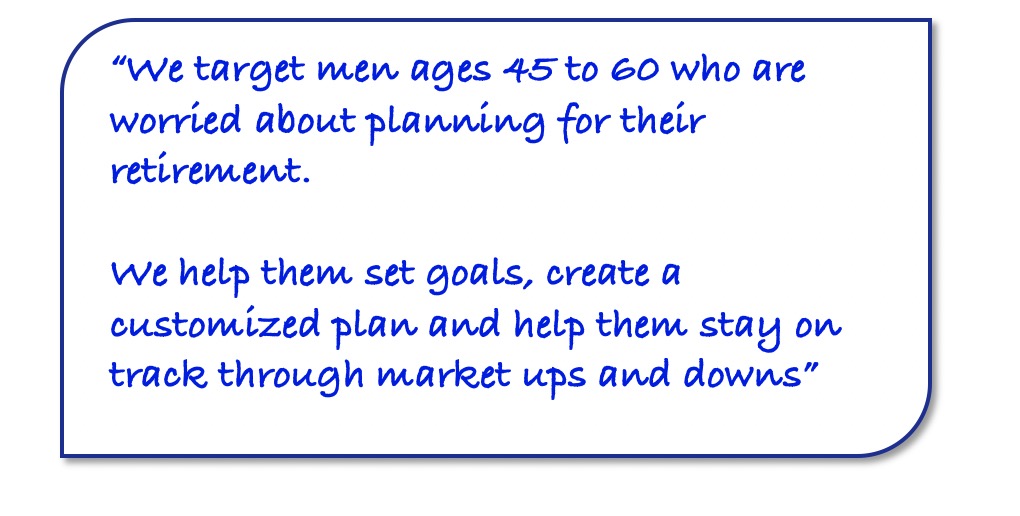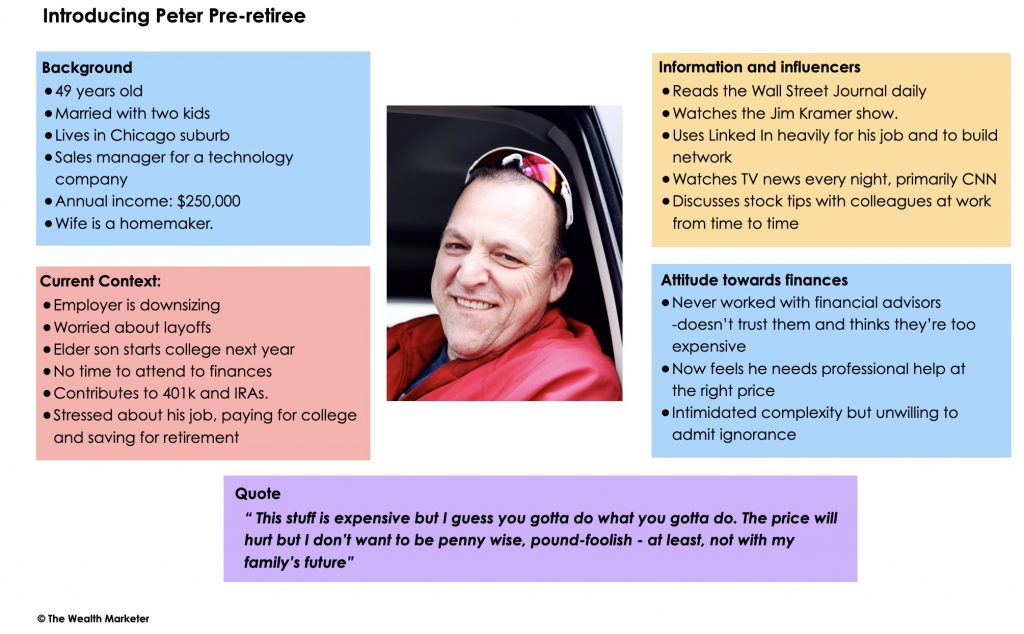
So many times I feel that marketing complicates things needlessly.
Do you feel this way too?
Take, for example, the most basic of all marketing activities: figuring out who your ideal clients are, and how to find them and help them so they become fans of you and your business.
Having this picture with high-fidelity, high-resolution clarity in your head can do wonders for your rainmaking:
- Maximize the productivity of your time – only engage with people you’re likely to close
- Sharpen your approach so it feels resoundingly convincing to those you do want to serve
- Increase your focus – find the exact types of clients you’re most likely to succeed with
So how do you create this picture-perfect image in your head?
Do even the most preliminary search on Google and you’ll find your head swimming with all the terminology, the techniques and needless obfuscation.
Forget all that complexity.
Here’s a simple approach that if you spend just 30 minutes with a pen and paper in a quiet spot, can pay you back at least 30 times over – saving you time and needless frustration.
But first, I want to introduce you to someone very important – the persona.
What Is A Persona
“Persona” or “Ideal client persona” is just a fancy term for making very tangible and real all the details and dimensions of your ideal client.
It’s a true-to-life picture of an actual person you could imagine talking to, and dealing with.

Photo by Flavius Călin
Which of these two approaches gets you energized and confident about finding, engaging and converting to a client?
This:

Or this:

Don’t you feel a lot more confident that you can track down and close a deal with Peter – more so than with the vague “45 to 60 year old employed executive”?
For example, you now know:
- Where to find Peter – Linked In would be a great channel, for example, because he’s spending a ton of high-focus time on it everyday, and in a professional, business-like mindset too.
- What problem to hook his attention with – anything to do with smart tips for college planning, or catch-up retirement planning strategies, for example, will likely catch his attention
- What points to highlight about your offering – it’s clear he has an inaccurate picture of the financial advice industry. So educating him on the different models of financial planning and pricing would be a great way to earn his trust and give him value
- How to craft the journey to a successful relationship – it’s clear Peter doesn’t like to admit what he doesn’t know, probably because of his distrust of the industry. So an approach that highlights what other smart investors or individuals like him do to safeguard their finances will probably be much more effective to win him over.
At a stroke, you’ve gotten clear answers to the biggest questions that will make or break whether you’ll succeed with Peter – and the thousands of others just like him who are also a great fit for your offering.
Now that you’ve seen the power of the persona, how do you go about creating one?
Do even a little bit of online research, and you’ll see there’s hardly any consensus on what needs to be on your persona, how you find it, or even how best to use one once you have a persona.
A Simple Way to Build Great Client Personas
I’ve done the work and simplified it for you, so you can have a pretty good answer in 30 minutes or less.
Of course the more effort, thoughtfulness and hard data you can bring to this exercise, the better your results will be.
But even a quick-and-dirty focused session can get you immense improvements in your targeting, messaging and engagement.
Let’s get to it:
Step 1: Identify The Candidates
How many personas do you need to build for your business?
It depends on how big your business is. To begin with, experts recommend creating no more than 2-3 personas.
How do you find these personas?
- Take a quick look at the full list of your clients, past and present
- Find what patterns pop from the data: are there clusters around:
- Demographics – specific age groups, occupations, family statuses?
- Service offerings – of you offer more than one specialization – are there some that are more popular than others? For example, is your “business owner” package more popular than your “employee plan” package?
- Investment profiles – Is there an over-representation of people who have a specific type of investment preference?
It may help to run some basic analytics to see if there are invisible patterns that show up.
If you’re just starting out, then focus on the types of clients you’d like to serve.
From this, pick at most 2-3 clusters that pop and resonate with you.

Photo by Mathieu Stern
Step 2: Stake Out the Angles
The goal is that when you’re done, you want to have everything you need to find, attract and engage this person as effectively and efficiently as possible. In other words, you want your persona to act as both a compass and a roadmap.
What dimensions do you need to get you there? Start with these seven:
- Human dimensions that make your persona identifiable: this means their gender, age, occupation, family status, where they live, education and of course, their income and /or net worth. If you’re really playing for the prize, I’d also consider adding ethnicity and affiliations. Most important, give your persona a name
- Problem – What is the specific financial problem that’s disturbing their equilibrium. How do they experience it? What areas of their daily life does it impact?
- Relief needed – What’s the “pain-killer” that will make this pain go away? Is it the comfort of having a plan? Is it the emotional assurance that comes from having an expert they can rely on? These may feel like details but understanding these small nuances is incredibly important to crafting a razor-sharp marketing approach
- Information channels – Where does this prospect get their information? What are their hangouts? Where do they get “social” information? And where do they get their “serious, business” information about their finances, career, etc. Who do they trust?
- Barriers and fears – What does this person distrust, fear or dread the most when it comes to your offering? Is that barrier internal to them? Does it relate to your entire industry? Or just your profession?
- Persuaders and influencers – What emotional factors nudge this person towards a “yes”? Is it the recommendation of friends? The authority of industry rankings? The likability factor of having a chat with you? who do they listen to for advice on their finances?
- Experience expectations – What do they expect will happen in this relationship? Are those accurate? What do they expect to see, feel, hear and have happen? When? How can you remove misconceptions and build more realistic benefits-based expectations instead?
Step 3 – Build a True-to-life, Fact-based Picture
No that you’ve created the frame for your portrait, you need to fill it in.
At the end of it you should have a such a human picture that you can visualize your ideal client walking into your office and having a real, meaty conversation that you’re more than ready to tackle.
How do you get this realistic, pulsating picture?
- Recall client and prospect conversations you’ve had. Jot down everything you can remember relating to each of these seven dimensions. Use the same words, language and expressions that you have heard your clients and prospects use
- Do internet research – visit blogs, Facebook groups, and even subreddits dedicated to this subject and demographic to identify what they’re really thinking and feeling – that they may never tell you in a face to face conversation. While you’re at it, dig deep into book reviews on the topic of your offering.
- Talk to your colleagues and staff to generate more ideas – you’ll hear different but equally valuable perspectives that will inform your picture and make it much richer
- Be careful to grab at least 1-2 quotes that pithily capture your persona’s mindset, attitude to life, preoccupation or concern
Capture all of this in a simple template similar to the one I shared before.
You don’t have to get fancy – a simple Powerpoint slide or even Word or Excel document is plenty
Pro-tip: Don’t forget to add a photograph that’s representative of this client. You can find free, high-quality pictures at Unsplash.com or an even bigger selection at any of the paid services such as iStockPhoto.com

Photo by Jelleke Vanooteghem
Getting Value Out of Your Client Persona
Don’t make the mistake many other businesses make in spending an enormous amount of time in building out a shiny persona – and just letting it sit on a hard drive somewhere.
Your persona is only valuable when you use it.
Here are four ways to use your persona to drive better marketing:
1) Select the right channels:
Use the right channels to build awareness for your business and platform. A word of caution: just because your ideal client is on Facebook a lot doesn’t necessarily mean that they’ll respond to your Facebook marketing. It’s a delicate combination fo the channel and purpose. If they come to Facebook mainly for entertainment, their eyes might glide right past your earnest announcement of a free webinar.
2) Position your business for leadership:
The key to success in marketing is being the “one and only” in your prospects’ minds. But how do you carve this spot?
To get this right, look to a combination of both characteristics unique to YOU as well the things that THEY consider important.
For example, if your persona is big on community participation and leadership, emphasize that your firm’s long presence in and service to the local community.
3) Craft the perfect content:
Stuck for content ideas? Your persona will give you all you need and more.
Look to the fears, challenges and barriers your ideal client faces to shape the content you write about. When you do this, over time you’ll begin to look like the heaven-sent, perfect answer to your ideal client’s financial problems – in EXACTLY the way they’re looking at it.

Photo by Jess Bailey
4) Be there every step of the journey
There’s an even bigger content benefit that compounds over time.
Because you’ll cover topics that become important at different stages of their commitment journey, you’ll have content that appeals to them no matter which stages of the process they’re at, making your foresight seem almost magical, and making you look like a genius
Beyond these four immediate uses, having your persona front and center delivers ongoing and repeated benefits to your business. For example:
- Keep this picture in front of you to write compelling client communications
- Write your market commentaries as if you’re speaking to this person – and addressing their specific fears, questions and challenges from whatever the market is doing at the moment
- When crafting new service offerings, ask what this person would think of it? Or if you need an entirely new persona to take advantage of all that you have to offer.
There you have it. To get started, a focused 30-minute session is more than enough.
Who’s your ideal client?